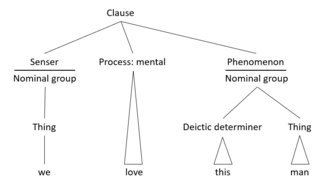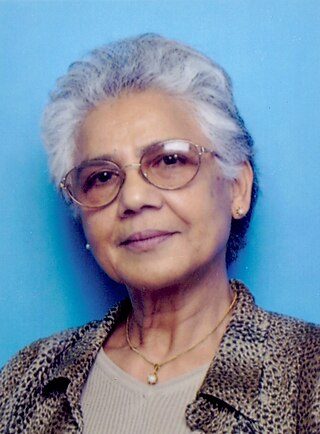
Ferdinand de Saussure was a Swiss linguist, semiotician and philosopher. His ideas laid a foundation for many significant developments in both linguistics and semiotics in the 20th century. He is widely considered one of the founders of 20th-century linguistics and one of two major founders of semiotics, or semiology, as Saussure called it.

Functional linguistics is an approach to the study of language characterized by taking systematically into account the speaker's and the hearer's side, and the communicative needs of the speaker and of the given language community. Linguistic functionalism spawned in the 1920s to 1930s from Ferdinand de Saussure's systematic structuralist approach to language (1916).
The following outline is provided as an overview and topical guide to linguistics:

Michael Alexander Kirkwood Halliday was a British linguist who developed the internationally influential systemic functional linguistics (SFL) model of language. His grammatical descriptions go by the name of systemic functional grammar. Halliday described language as a semiotic system, "not in the sense of a system of signs, but a systemic resource for meaning". For Halliday, language was a "meaning potential"; by extension, he defined linguistics as the study of "how people exchange meanings by 'languaging'". Halliday described himself as a generalist, meaning that he tried "to look at language from every possible vantage point", and has described his work as "wander[ing] the highways and byways of language". But he said that "to the extent that I favoured any one angle, it was the social: language as the creature and creator of human society".

Systemic functional grammar (SFG) is a form of grammatical description originated by Michael Halliday. It is part of a social semiotic approach to language called systemic functional linguistics. In these two terms, systemic refers to the view of language as "a network of systems, or interrelated sets of options for making meaning"; functional refers to Halliday's view that language is as it is because of what it has evolved to do. Thus, what he refers to as the multidimensional architecture of language "reflects the multidimensional nature of human experience and interpersonal relations."

Course in General Linguistics is a book compiled by Charles Bally and Albert Sechehaye from notes on lectures given by historical-comparative linguist Ferdinand de Saussure at the University of Geneva between 1906 and 1911. It was published in 1916, after Saussure's death, and is generally regarded as the starting point of structural linguistics, an approach to linguistics that was established in the first half of the 20th century by the Prague linguistic circle. One of Saussure's translators, Roy Harris, summarized Saussure's contribution to linguistics and the study of language in the following way:
Language is no longer regarded as peripheral to our grasp of the world we live in, but as central to it. Words are not mere vocal labels or communicational adjuncts superimposed upon an already given order of things. They are collective products of social interaction, essential instruments through which human beings constitute and articulate their world. This typically twentieth-century view of language has profoundly influenced developments throughout the whole range of human sciences. It is particularly marked in linguistics, philosophy, psychology, sociology and anthropology.
Social semiotics is a branch of the field of semiotics which investigates human signifying practices in specific social and cultural circumstances, and which tries to explain meaning-making as a social practice. Semiotics, as originally defined by Ferdinand de Saussure, is "the science of the life of signs in society". Social semiotics expands on Saussure's founding insights by exploring the implications of the fact that the "codes" of language and communication are formed by social processes. The crucial implication here is that meanings and semiotic systems are shaped by relations of power, and that as power shifts in society, our languages and other systems of socially accepted meanings can and do change.

In systemic functional grammar (SFG), a nominal group is a group of words that represents or describes an entity, for example The nice old English police inspector who was sitting at the table with Mr Morse. Grammatically, the wording "The nice old English police inspector who was sitting at the table with Mr Morse" can be understood as a nominal group, which functions as the subject of the information exchange and as the person being identified as "Mr Morse".
Structural linguistics, or structuralism, in linguistics, denotes schools or theories in which language is conceived as a self-contained, self-regulating semiotic system whose elements are defined by their relationship to other elements within the system. It is derived from the work of Swiss linguist Ferdinand de Saussure and is part of the overall approach of structuralism. Saussure's Course in General Linguistics, published posthumously in 1916, stressed examining language as a dynamic system of interconnected units. Saussure is also known for introducing several basic dimensions of semiotic analysis that are still important today. Two of these are his key methods of syntagmatic and paradigmatic analysis, which define units syntactically and lexically, respectively, according to their contrast with the other units in the system. Other key features of structuralism are the focus on systematic phenomena, the primacy of an idealized form over actual speech data, the priority of linguistic form over meaning, the marginalization of written language, and the connection of linguistic structure to broader social, behavioral, or cognitive phenomena.

Relational Network Theory (RNT), also known as Neurocognitive Linguistics (NCL) and formerly as Stratificational Linguistics or Cognitive-Stratificational Linguistics, is a connectionist theoretical framework in linguistics primarily developed by Sydney Lamb which aims to integrate theoretical linguistics with neuroanatomy. It views the linguistic system of individual speakers, responsible for language comprehension and production, as consisting of networks of relationships which interconnect across different "strata" of language. These relational networks are hypothesized to correspond to neural maps of cortical columns or minicolumns in the human brain. Consequently, RNT is related to the wider family of cognitive linguistic theories. Furthermore, as a functionalist approach to linguistics, RNT shares a close relationship with Systemic Functional Linguistics (SFL).

Ruqaiya Hasan was a professor of linguistics who held visiting positions and taught at various universities in England. Her last appointment was at Macquarie University in Sydney, from which she retired as emeritus professor in 1994. Throughout her career she researched and published widely in the areas of verbal art, culture, context and text, text and texture, lexicogrammar and semantic variation. The latter involved the devising of extensive semantic system networks for the analysis of meaning in naturally occurring dialogues.
Lexicogrammar is a term directly related to systemic functional linguistics. Systemic functional linguistics is a specific approach to adding as much detail as possible when describing lexicogrammar. It was coined by Michael Halliday, the father of systemic functional linguistics, to describe the continuity between grammar and lexis. For many linguists, these phenomena are discrete. But Halliday brings them together with this term. As with other dimensions of Halliday's theory, he describes the relation of grammar to lexis as one of a 'cline', and therefore, one of 'delicacy'. In 1961, he wrote 'The grammarian's dream is...to turn the whole of linguistic form into grammar, hoping to show that lexis can be defined as "most delicate grammar". In 1987, Ruqaiya Hasan wrote an article titled 'The grammarian's dream: lexis as delicate grammar', in which she laid out a methodology for mapping lexis in Halliday's terms.

James Robert Martin is a Canadian linguist. He is Professor of Linguistics at The University of Sydney. He is the leading figure in the 'Sydney School' of systemic functional linguistics. Martin is well known for his work on discourse analysis, genre, appraisal, multimodality and educational linguistics.

Christian Matthias Ingemar Martin Matthiessen is a Swedish-born linguist and a leading figure in the systemic functional linguistics (SFL) school, having authored or co-authored more than 100 books, refereed journal articles, and papers in refereed conference proceedings, with contributions to three television programs. One of his major works is Lexicogrammatical cartography (1995), a 700-page study of the grammatical systems of English from the perspective of SFL. He has co-authored a number of books with Michael Halliday. Since 2008 he has been a professor in the Department of English at the Hong Kong Polytechnic University. Before this, he was Chair of the Department of Linguistics at Macquarie University in Sydney.
The term metafunction originates in systemic functional linguistics and is considered to be a property of all languages. Systemic functional linguistics is functional and semantic rather than formal and syntactic in its orientation. As a functional linguistic theory, it claims that both the emergence of grammar and the particular forms that grammars take should be explained "in terms of the functions that language evolved to serve". While languages vary in how and what they do, and what humans do with them in the contexts of human cultural practice, all languages are considered to be shaped and organised in relation to three functions, or metafunctions. Michael Halliday, the founder of systemic functional linguistics, calls these three functions the ideational, interpersonal, and textual. The ideational function is further divided into the experiential and logical.

The cline of instantiation is a concept in systemic functional linguistics theory. Alongside stratification and metafunction, it is one of the global semiotic dimensions that define the organization of language in context.
The idea of language as a linguistic system appears in the linguistic theory of Ferdinand de Saussure, J.R. Firth, Benjamin Lee Whorf, Louis Hjelmslev, and Michael Halliday.
Alice Marie-Claude Caffarel-Cayron is a French-Australian linguist. She is an Honorary Senior Lecturer in Linguistics at the University of Sydney. Caffarel is recognized for the development of a Systemic Functional Grammar of French which has been applied in the teaching of the French language, Discourse analysis and Stylistics at the University of Sydney. Caffarel is recognised as an expert in the field of French Systemic Functional Linguistics (SFL).
Frances Helen Christie, is Emeritus professor of language and literacy education at the University of Melbourne, and honorary professor of education at the University of Sydney. She specialises in the field of systemic functional linguistics (SFL) and has completed research in language and literacy education, writing development, pedagogic grammar, genre theory, and teaching English as a mother tongue and as a second language.
In linguistics, stratification is the idea that language is organized in terms of hierarchically ordered strata. This notion can be traced back to Saussure's dichotomy between signified and signifier and Hjelmslev's expression plane and content plane, but has been explicictly explored as a theoretical concept in stratificational linguistics and systemic functional linguistics.










